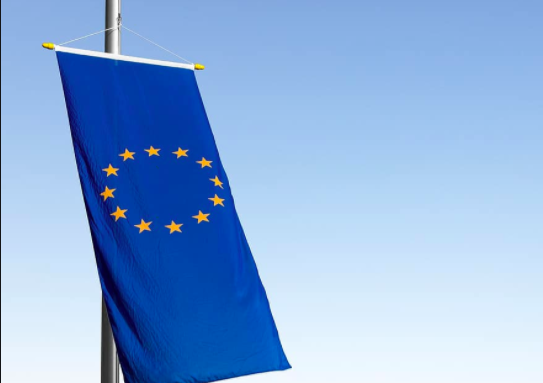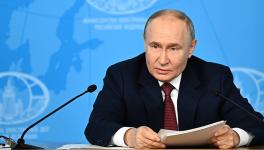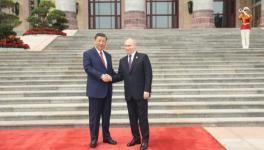Every Step the EU Takes Toward Financial Unity Sows New Seeds of Its Potential Collapse

Samuel Beckett’s “Waiting for Godot” is a play featuring two characters waiting for a character, Godot, who never arrives. As such, it is a useful metaphor for the goings-on of the European Union (EU). Observers of the EU’s evolution in the capital of Brussels have witnessed a Godot-like experience of the promised arrival of the long-awaited resolution of the group’s dysfunction and economic malaise that never happens. The pattern is virtually always the same: the countries meet, they squabble, and then they emerge with a “landmark” or “historic” compromise that deals the lowest common denominator in terms of economic impact.
True to form, the EU Joint Declaration characterized the newly created €750 billion recovery fund as an “ambitious and comprehensive package combining the classical [budget] with an extraordinary recovery effort destined to tackle the effects of an unprecedented crisis in the best interest of the EU.”
That is typical Brussels-driven hyperbole. There are some important new policy developments that give a small glimmer of hope to those hoping to nudge the EU toward full-on debt mutualization: that is to say, to jointly issue a common debt instrument of a pan-European institution (as opposed to national sovereign bonds) to fight the outbreak and its effects. The pooling of liabilities of the European Union nations and linking them to the EU’s currency issuer, the European Central Bank, are an important series of precedents, and there’s also the positive benefit of providing more fiscal support to the severely indebted countries of southern Europe (although, as usual, not enough).
On the other hand, that is precisely why the wealthier northern countries resist it: they fear that such mutualization would derogate from their own pristine credit ratings, while simultaneously allowing the so-called profligate “Club Med” countries to free-ride and avoid making reforms to their own systems.
Caught in the middle of this conflict is France, a nation that, along with Germany, is the fulcrum on which the entire European project turns. It is a country with a history of global aspiration, but its economy contains many of the weaknesses of the southern periphery countries. The government of Emmanuel Macron was one of the leading actors behind the latest initiative. But at the end of a marathon negotiating session, there was virtually nothing on the table for France itself in terms of direct aid or broad concessions toward enhanced debt mutualization. This is highly problematic, as France too has extremely high debt levels and is one of the biggest economic casualties of COVID-19.
France’s current political strategy is reminiscent of its thinking during the negotiations that led to the common currency. At that time, French President François Mitterrand calculated that the creation of the euro would provide the means whereby France could mitigate the economic power of Germany. That proved to be a fatal miscalculation.
Similarly, President Macron is seeking to use today’s recovery fund as a means of nudging the EU closer to the goal of debt mutualization. The history of the European Union suggests that such Gallic aspirations are likely to be frustrated again. France may indeed be one of Europe’s “founding fathers,” but it is a hungry parent that has fallen on hard times. National pride (and perhaps fears that the markets will eventually cotton on to its vulnerabilities if the government draws too much attention to them) has precluded it from acknowledging its needs, but if those weaknesses remain unaddressed, anti-euro populism could well surge in France (as it has in Italy). At that point, the European Union will truly have an existential crisis on its hands.
In theory, debt mutualization is the glue that could bind together a bunch of federated states, as Alexander Hamilton did for the United States. But in practice, such proposals in the past have been the source of ongoing tension and dysfunction, especially within the eurozone. The attempts to bridge the gap have provoked yet more division and possible future splits among the various EU member states, exacerbated by the backdrop of a catastrophic pandemic, which means that incrementalism won’t deliver the goods.
On to the details: the fund will disperse €390 billion in grants (with the remainder in the form of loans), spread among the member countries, with a net fiscal impact of roughly 0.6 percent of GNI. This is paltry in the context of a continent in which double-digit contractions of GDP are forecast by the IMF in some of Europe’s largest economies (e.g., in Italy, France, Spain, and the United Kingdom). Even countries thought to have handled the coronavirus well, such as Germany, are forecast to contract by almost 8 percent this year.
The funds will be borrowed directly by the European Commission (EC), who (per the Financial Times) will “establish a yield curve of debt issuance, with all liabilities to be repaid by the end of 2058.” As the bonds remain a liability of the EC, they consequently won’t be added to the national balance sheets of the distressed countries that will be the main recipients. These borrowings from the capital markets will be supplemented by existing national contributions to the overall EU budget. The latter provision created another stress point that was relieved by the usual expedient of providing additional budget rebates—basically cash back on their annual EU contributions—to the so-called “frugal five” (Finland, Austria, the Netherlands, Denmark and Sweden) in order to enable those countries’ leaders to sell the package to the respective national parliaments (where it still must be ratified). Effectively, the wealthiest countries are being bribed with offsets to secure agreement.
In terms of the mechanics of how the money from the recovery fund is spent, the proposed usage is subject to objection by any national state for three months. This is more akin to a time-limited pause, as opposed to an outright veto. The objections can ultimately be overridden by the European Commission, the EU’s executive arm that is responsible for drawing up proposals for new European legislation and implementing the decisions of the European Parliament.
That override feature has led to some of the rhetorical excesses used to characterize the agreement. In reality, however, the power to override opens the door to debt mutualization by a sliver, if at all. Furthermore, the history of the EU shows that objections can turn into larger gridlock and opposition, especially as the EC largely shares the austerian and neoliberal biases of the northern European bloc. Hence, the “reforms” that the EC will likely demand as a quid pro quo for receiving the emergency funding likely means more cutbacks in government social spending that will be highly deflationary (the EC has already demanded such changes from Italy in the past). Hence, the program is not a bellwether for the end of austerity economics, as some have suggested. In addition to these usual north versus south splits, another level of conflict between western and eastern Europe could be added to this volatile mix, if the Dutch or the Nordic countries make aid to Hungary and Poland conditional on ongoing respect to the rule of law (as has been reported here).
Ambrose Evans-Pritchard, the Daily Telegraph’s international business editor, describes the recovery fund “as a one-off episode that does not lead to fiscal union or change the EU’s constitutional structure. Everything reverts to the status quo ante, which is why it is tolerated by hardliners in the German Council of Economic Experts.” Despite more emollient noises by Chancellor Angela Merkel (who will be leaving office next year), the German government on the whole remains implacably opposed to EU debt mutualization. Other countries that share Berlin’s opposition also include the Netherlands, Finland, Austria, Denmark and Sweden.
Evans-Pritchard’s characterization of the agreement may be a bit extreme: The French in particular hope that the EC’s ability to override national vetoes will ultimately provide a pathway to full debt mutualization. After all, it was the Macron government that originally pushed the idea of a common European fund, even though Paris accepted time limitations on the proposed instruments, in order to head off anticipated German and Dutch opposition to the overall concept. But in a subsequent analysis of the agreement, Evans-Pritchard also highlighted the summit communique’s characterization of the recovery fund as “a temporary facility to cope with a one-off event and should not be taken as a precedent.”
So tension remains, even as debt mutualization looks marginally more possible today than it was before the agreement was secured. So while Evans-Pritchard may be right to call the package “political nitroglycerine on a long fuse,” the fact is that this program establishes a new set of behaviors and precedents for EU allocation of funds. It’s messy and potentially explosive, as all such European compromises tend to be, but such messy ambiguity almost certainly means we will witness similar conflicts in the future.
The problem is that time is running out as the continent faces economic problems of a magnitude not experienced since the end of World War II. While the exigency of the pandemic is slowly pushing the EU member states toward going further than they have gone before, the very unpredictability created by the coronavirus makes it difficult to determine what kinds of spending will provide optimal outcomes. There will likely be a good amount of failure that will provide a bounty of evidence for the frugal five austerians, who remain profoundly suspicious of anything that remotely approximates activist fiscal policy. Likewise for the euro-skeptics if the marginal amounts allocated under this program fail to alleviate economic stress.
Extraordinary circumstances demand extraordinary measures and, short of war, it is hard to envisage a more damaging backdrop than a pandemic, which has single-handedly forced the shutdown of the global economy and continues to act as a brake on recovery, as each new outbreak creates the possibility of renewed shutdowns. That kind of an environment not only makes consumers more hesitant to spend money (given renewed uncertainty about collective employment, to say nothing of the risk of jobs being lost forever—and perhaps with good reason, considering the likely fall-off in air travel, restaurants, and other forms of leisure activities). Likewise, businesses are increasingly reluctant to invest in that kind of an environment.
All of which also complicates the task of government fiscal policy. The latter is supposed to fill in the spending gaps left open by the withdrawal of the private sector. But how can this be achieved effectively if the promotion of economic demand conflicts with the resolution of a public health emergency (that entails scaled-down activity to eradicate the presence of the coronavirus)? The task of focusing on reconstruction also becomes more problematic, as nobody can adduce fully the shape of the future post-pandemic economy, thereby complicating the task of determining how to allocate structural funding to assist in the economic transition.
Most commentary pertaining to the damage inflicted by the coronavirus has focused on Italy and Spain. And, indeed, both countries now feature governing coalitions whose attachment to the euro is lukewarm at best. Italy, in particular, has always been viewed as the greatest existential threat to the single currency union.
But while Italy’s government managed to secure a reasonable chunk of the recovery fund’s grant money (around 23 percent of the total), there is not a lot left over for France. It is, however, worth noting that France’s debt to GDP is rapidly approaching Italianate levels, and the French economy is forecast by the IMF to shrink by 12.5 percent this year.
Despite these ominous developments, the Macron administration’s longer-term goals still point to an embrace of neoliberal orthodoxy in a manner that could further contract demand and therefore elevate the country’s public debt to GDP ratio. Although the French government has deferred its planned “flagship pension reforms” for a year in order to deal with the pandemic, it insists that it still plans to follow through with them (pushing back the retirement age for many workers, as well as “reduc[ing] insurance payouts for high earners and requir[ing] people to work for longer before claiming benefits,” according to the Financial Times). The last time the government attempted changes like these, the “yellow vests” protests brought the country to a standstill.
I have long felt that France, as much as Italy, could ultimately prove the weak link that would potentially blow up the European Monetary Union, given the structural divergences in their respective economies vis-à-vis Germany. Had economics alone determined the creation of a new supranational currency, a more viable currency zone would likely have been restricted to a quasi-Deutsche Mark bloc comprising Germany, the Benelux countries, and a few of the Nordic nations. These countries shared a high degree of pre-existing economic/social/cultural convergence even before the creation of the euro.
But the creation of the euro was clearly not done on economic considerations alone. Years ago, I posited the idea that German industrialists backed the idea of a “big and broad” euro in the early 1990s so as to lock in Germany’s ongoing industrial dominance, despite the objections of the Bundesbank. They were supported by then-Chancellor Helmut Kohl, who was a Europeanist to the core. France wanted to join because it (naively) assumed that it could control Germany politically by taking a key role in the common currency, a miscalculation as grave as relying on the Maginot Line for national defense. Italy wanted to join because it was a founding member, and the neoliberals who dominated economic policy-making in Rome calculated that this would represent a good way to re-circuit the fundamentals of its economic behaviors and thereby override its long-standing political dysfunction.
These problematic calculations on all sides contributed to what remains a largely dysfunctional monetary union. For a time, it provided the illusion of prosperity and “ever closer” political union. COVID-19 has blown apart that illusion as easily as the wind knocking over a house of cards. The French have been pushing hard for debt mutualization precisely because the country now faces risks comparable to those of Italy, even though the markets have until now given Paris the benefit of the doubt (which is why French bond yield spreads relative to German bonds remain comparatively low). In the context of the pandemic, incrementalism might work for Germany and its northern European counterparts, but it is unlikely to work for France. The violent protests in 2018 of the “yellow vests” (which mirror decades of earlier incidents of civil unrest) and the corresponding rise of populist parties in France point to the unlikelihood that the French government could sustain the kind of economic punishment that has been inflicted on countries like Italy, Greece and Spain, even though many of France’s problems mirror those of the other “Club Med” nations.
The Paris-Berlin axis has long been the motor behind the entire European project. Much as France’s Henry IV once (apocryphally) declared that “Paris is worth a mass,” when the Huguenot king converted to Catholicism in order to ensure maximum political legitimacy for his rule, Germany and the frugal five therefore have to determine whether or not debt mutualization (or some other form of European integration) is a price worth paying in order to prevent total fragmentation.
Simply waiting for a mythical Godot, as Beckett highlighted, will get us nowhere.
Marshall Auerback is a market analyst and commentator.
This article was produced by Economy for All, a project of the Independent Media Institute.
Get the latest reports & analysis with people's perspective on Protests, movements & deep analytical videos, discussions of the current affairs in your Telegram app. Subscribe to NewsClick's Telegram channel & get Real-Time updates on stories, as they get published on our website.
























